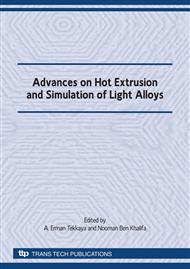p.205
p.213
p.221
p.227
p.235
p.241
p.249
p.257
p.265
Manufacturing of Carbon/Resin Separator by Die Sliding Extrusion
Abstract:
A fuel cell will play a part of a module of power generator instead of an internal- combustion engine. It is required to improve the productivity and miniaturizing of the fuel cell. The separator in the fuel cell is an important part. The manufacturing process of carbon/resin separators usually is injection molding or compression forming. On the other hand, the authors have developed die sliding extrusion based on the friction extrusion [1] and side flow extrusion [2]. The die sliding extrusion is a kind of valuable shape extrusion [3,4]. It is applied to manufacturing fuel cell separators which have linear channels on its upper and lower surfaces in the orthogonal direction.
Info:
Periodical:
Pages:
235-240
Citation:
Online since:
December 2009
Authors:
Price:
Сopyright:
© 2010 Trans Tech Publications Ltd. All Rights Reserved
Share:
Citation:


